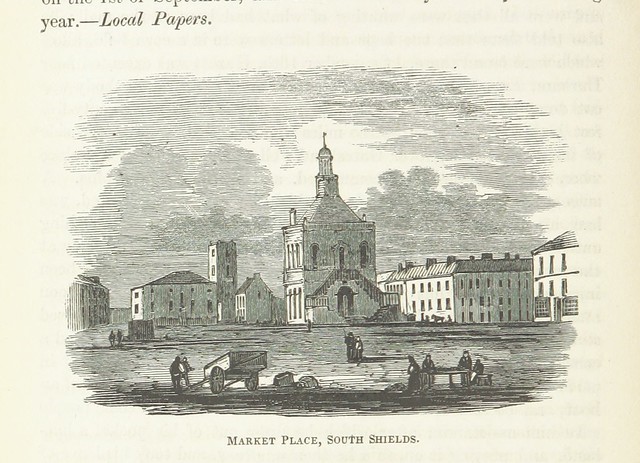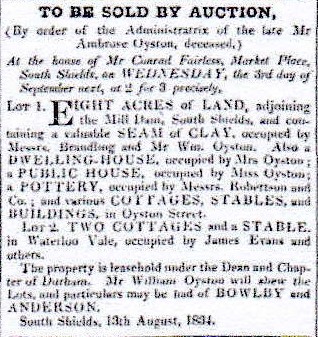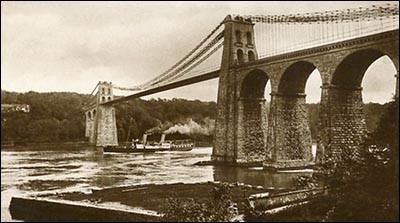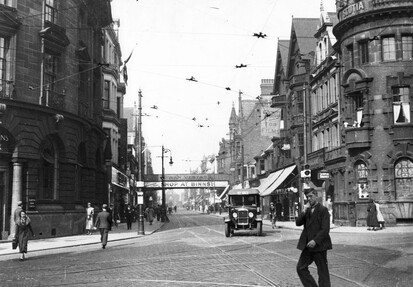
POSTS can now be found under PROJECTS.
| < PART 3 | PART 5 > |
RUSSELL BOWLBY (1792-1865)
THE LIFE AND TIMES OF THE MEMBER OF PARLIAMENT THAT NEVER WAS!
28 JUNE 2020

PART 4: Career - Rise and Fall
In 1815 Russell Bowlby started to practice as a solicitor in South Shields and Bishopwearmouth and he continued to do so, intermittently in South Shields with chambers in Chapter Row and Wallis Street until 1863.
INDENTURES
'On the 20th May 1815 made between Russell Bowlby of South Shields in the County of Durham Gentleman, Solicitor in His Majesty's High Court of Chancery and one of the Attornies of His said Magesty's Court of King's Bench at Westminster and all of the Temporal Courts within the County Palatine of Durham and Sadberge'.
He signed a further seven indentures for the tutelage of articled clerks over a period of seventeen years. Later that year he completed his cousin Peter Bowlby's indenture. In the years that followed by John Carlen Heath, John Twizell Wawn, Christopher Aikenhead Wawn, George Anderson and finally his nephew Thomas William Bowlby. In 1827, he sponsored his son John Russell Bowlby to his then partner Henry Anderson (1).
PRACTICE
The first reference to Russell Bowlby as a practicing solicitor was in 1816 in Sunderland when he conducted an inquest into the drowning of a sailor (2). Then in South Shields in 1817 he was the assignee in two cases of bankruptcy involving ship-owners; James Robb (3) and Robert Scotland (4) respectively. He was also the South Shields agent for the Equitable Assurance Society of Blackfriars, London (5).
By 1825 Russell Bowlby was in partnership with Henry Anderson. Several notices appertaining to the selling of properties including by auction appeared in the Newcastle Courant; two shops and houses in Wapping Street (30th April 1825); house, shops and candle manufactory near the Stone Quay (26 April 1828 p. 3); the dry docks and associated buildings in the Long Row South Shields (11th October 1828, p.3). He also acted in the sale of properties in Durham City (25th April 1829, p.3) (6).
There are countless notices relating to Bowlby and Anderson. It is of the proposed auction in the Durham Chronicle and Sunderland Times of the 25th August 1834 that is of particular significance to me as it refers to James Evans, ship-builder and ship-owner, my Great Great Great Grandfather.

SUSPENSION BRIDGE BETWEEN SOUTH SHIELDS AND NORTH SHIELDS
In 1825 Russell Bowlby first declared a commercial interest in the improvement of communications to and from South Shields. Together with fellow solicitors John Tinley and Jonathan Cockerill they developed a company to build the bridge between South Shields and North Shields in the style of the Menai Suspension Bridge (1819-1826) linking Bangor to Anglesey. They made application to Parliament on the 1st November 1825 following a feasibility survey by Thomas Telford dated 27th October 1825 (7).

Ynys y Moch, Menai Bridge: courtesy of Prof Hywel Wyn Owen, Welsh Place-Name Society & Menai Bridge Town Council
This received Royal assent by King William IV. Captain Samuel Brown, RN was charged with the responsibility of designing a bridge across the Tyne between St David's Mount in North Shields and in Westoe Road, South Shields which was to 'be of sufficient height above the water to permit ships to sail underneath without striking their masts!' (8). The funds to cover the estimated cost of £150,000 were not secured and by 1827 it was abandoned (9). This was in part because of the intervention of the Dean and Chapter of Durham in the relaxation of their control of ferry rights on the River Tyne.
FERRY BETWEEN SOUTH SHIELDS AND NORTH SHIELDS
This was agreed in 1828 on the basis that the Dean and Chapter would receive 1/15th of the profits with the development of a ferry service between the two towns through the auspices of the North and South Shields Ferry Company.
Once the application to Parliament for a suspension bridge across the river had been withdrawn, in October 1828, solicitors Russell Bowlby and his partner in practice, Henry Anderson together with John Tinley from North Shields gave notice of the planned bill for a toll-paying ferry across the river (10).
SUNDERLAND HARBOUR
His commitment to improved river crossings extended to Sunderland and the presentation of a Bill in March 1830 for the 'Improvement and Preservation of the River Wear, and the Port and Haven of Sunderland, in the County Palatine of Durham'. On the enactment of the bill, the Earl of Shaftesbury proposed that the petitioners should be named:-
Pr. 9.1.9. After ''Tennyon'' insert ''Lord Viscount Seaham, Lord Adolphus Vane, Hon. Charles William Lambton, Hon. George Frederick D'Arcy Lambton, Russell Bowlby of Cleadon, Thomas Bowlby (Sunderland), John Carr (Sunderland), Joseph Spence (Sunderland), Abraham Storey (Chester-le-Street), William Redhead (Newcastle), George Hill (Newcastle)'' (11).
LAW AND ORDER IN SOUTH SHIELDS
He was a member of South Shields Association for the Prosecution of Felons; whereby it was agreed to prosecute at joint expense felons who committed a crime against a fellow member. Solicitors: Bowlby & Anderson (12).
STANHOPE AND TYNE RAILROAD
Its inception Hodgson attributed to the Harrison family of Sunderland (13). Russell Bowlby prepared a deed of partnership on the 30th January 1832 for the inauguration of The Stanhope Railroad Company with offices in The Long Row. There was significant investment by local residents including William Wallis of Westoe, a speculator who early in 1832 agreed leases of coal seams at West Consett and Medomsley, and limestone quarries at Stanhope and John Rippon of Brinkburn Farm.
The first railway commissioned was the Stanhope and Tyne Railway running from Stanhope to South Shields to convey the minerals to the Tyne for transportation to the south. Rippon died soon afterwards and Wallis withdrew after two months retaining his investment of £3,000 in a bond.
Rather than petitioning parliament for an act to sanction the railway and to avoid publicity, which would have brought to light the extensive deposits of coal in the Durham Coalfield, voluntary arrangements were made with landowners for ‘way-leaves' (contract for permission to cross the land in return for a payment). It was small landowners who negotiated the excessive interest rates.
''It is enough to make a horse sick,'' wrote Russell Bowlby, ''to see parties, instead of blessing Providence for such a godsend, treating as if one was taking a road through a gentleman's pleasure ground.'' rather than in effect uncultivable land. £30 a year was paid for passing over a few yards of one farm at Boldon and £50 for passing over 110 yards of another, these rents being at the rate of £800 per mile with leases extending to 99 years (14).
The initial plans were for the railway to pass through South Shields at street level, was altered because of the objection of the South Shields Improvement Commissioners objected resulting in the construction of the bridge in 1833 across King Street.
In May 1834 the first locomotive (built by Robert Stephenson & Company) was placed on the line at South Shields and on 10 September 1834, the first public railway on Tyneside was in operation. Horse traction was used as well as locomotives, and the first consignment of coal was brought from the Medomsley collieries in a train of 100 wagons, and loaded onto the ship ''Sally''. Celebrations included a dinner for the 100 workmen and a grand banquet at the Golden Lion for 120 guests (15).
In April 1835, the railway began to carry passengers free of charge in coal wagons. Later carriages were attached and then an engine driven coach operated once a fortnight on paydays. The shareholders (including Russell Bowlby), seeing this as a public service and despite the fact that this was a loss-making venture wanted to continue even when the company was facing bankruptcy. Meanwhile, the landowners demanded higher charges for the way-leaves on the grounds that the earlier arrangement had been for the carriage of minerals only.
By the end of 1840 the Stanhope & Tyne Railroad company was unable to pay its debts and even though there was the prospect of a lucrative deal to provide the locomotives for the Durham Junction Railway on the 5th February 1841, the company was dissolved. As it was a partnership the partners were each liable (the cause of Russell Bowlby's bankruptcy) for the debt without limit. The authorised capital of the company was £150,000 and loans to the extent of £440,000 had been taken.
In March 1841, William Wallis petitioned for the repayment of £3,000 (Wallis v. Stanhope and Tyne Railway). It was correspondence written between William Wallis and Russell Bowlby produced in evidence that proved that Mr. Wallis had agreed to accept £2,000 down in lieu of £3,000 on the completion of the railway, and executed a release of the bond on the 16th of July, 1832 (16).
BANKRUPTCY
On the 9th April 1842 a Fiat in Bankruptcy was issued to him. However, on the 24th June The Lord High Chancellor accepted the recommendations of the Court of Review that in declaring his bankruptcy ‘Russell Bowlby of Bishopwearmouth' had conformed to all aspects of the Acts of Parliament relating to this and that he should be permitted to still pursue his career as a solicitor.
CONTINUING PRACTICE
Following his bankruptcy, I have been unable to find evidence of his professional practice. With the sale of Cleadon Meadows (Part 7) he lived and worked in Bishop Wearmouth living in Athenaeum Street but after 1848 his connection to Sunderland ended and he settled in Harton Village.
In 1862, three years prior to his death, he was practicing in South Shields representing William Musgrave, of East King-street, a Wire Worker and Weaver in his case of bankruptcy with Christopher Akenhead Wawn, his former pupil being the assignee in the case. Later that year, he was the Solicitor to the Executors of the estate of William Robertson Pawnbroker and Ship-owner.
Comments
Russell Bowlby was not only a successful solicitor but also a visionary seeing the development of both South Shields and Sunderland dependent on improved communications by the building of bridges across the Tyne and Wear. In the case of the Tyne, the fact that a Menai type suspension bridge was not built, meant an opportunity was indeed lost for the generations that followed which was not in fact resolved until the inauguration of the Tyne Tunnel.
By the age of 38 he had established connections to the significant landowners and business community of the North East in Georgian times whilst at the same time preparing to represent South Shields as a Liberal Reformer.
His philanthropy is again evidenced in his desire together with other shareholders to maintain passenger transport even in the face of bankruptcy and that the work of the men on the railway was in some small way, rewarded.
Like many of his generation, it was Russell Bowlby's involvement in the development of railways that was to lead to his eventual bankruptcy. I have written in greater detail about the railway to South Shields, because this was in many ways his lasting legacy to the town, which has never been acknowledged.

Railway Bridge circa. 1900
Photograph courtesy of South Tyneside Libraries
References
- Ancestry UK, Articles of Clerkship, 1756-1874
- Durham County Advertiser, 10th August 1816
- Durham County Advertiser, 3rd May 1817
- Durham County Advertiser, 12th July 1817, p.1
- Durham County Advertiser, 30th September 1820, p.1
- British Newspaper Archive-Newcastle Courant
- Durham County Advertiser, 19th Nov 1825
- An historical, topographical, & descriptive view of the county: Vol. 1 p.47 - Eneas Mackenzie, Marvin Ross
- 1827-Request for payment of call on shares in North and South Shields Bridge Company by Tinley, Cockerell and Bowlby (South Shields) (Ref: NCB I/JB 1488)
- 30 Newcastle Courant, 11th October 1828, p.3
- 'House of Commons Journal 11 May 1830', Vol. 85, 1830 (London), pp. 400-408-British History On-line
- Newcastle Courant, 19 Feb 1831
- 'The Borough of South Shields' by George B Hodgson, 1902, p.384
- Letter from Russell Bowlby to Andrew Stoddart, 25th November, 1832.
- 'The Borough of South Shields' by George B Hodgson, 1902, p.385
- Letter to Bowlby from Wallis ; Wallis v. Stanhope and Tyne Railway. Durham Advertiser, 12th March, 1841.